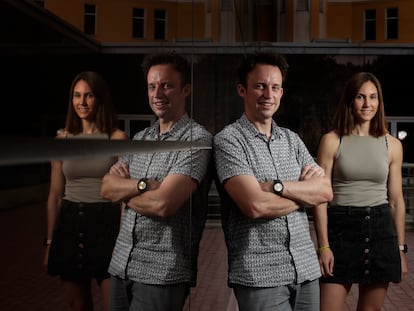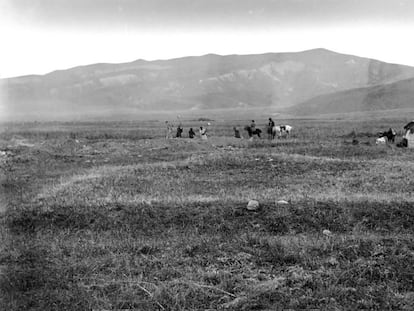The island that revealed the essence of humanity
A quarter century ago, the doctor Kári Stefánsson began examining the DNA of Iceland’s inhabitants in search of the genetic causes of illness
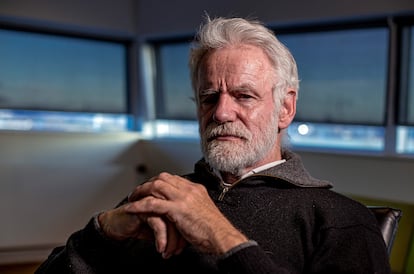
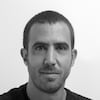
Kári Stefánsson has the blood of almost all of his countrymen stored beneath his office. He is a visionary Icelandic doctor, and a quarter century ago, he had an ambitious idea: to use his native country, a volcanic island near the Arctic circle, as a giant laboratory to examine the essence of human beings. Since then, more than half the population, some 180,000 volunteers, have responded to Stefánsson’s call. His company, deCODE, has analyzed all of their DNA, revealing thousands of genetic variants linked to common illnesses including cancer and Alzheimers. Francis Collins, ex-director of the United States’ National Institutes of Health, calls Stefánsson’s findings “the language of God.”
Reykjavik’s strange sunlight filters through the window, and Stefánsson reflects, pensive, on the religious metaphor. After 20 long seconds of silence, the doctor begins to speak. “I have difficulties with the kind of God Francis Collins believes in. If I were to run into the God Francis Collins believes in on the street today, the omnipotent God who can do everything, I would probably tell him that he was an unbelievable asshole. Why do you let war happen? Why do you let young children die?,” he inquires, gazing into space, as if he were speaking to a god present in the room.
A few meters below Stefánsson’s feet there is an immense freezer chamber, at 24 degrees Celsius below zero, in which robot hands handle tubs with blood samples from those 180,000 generous Icelanders who have offered their blood and medical history to a for-profit private company. Since 1996, deCODE has discovered thousands of risk factors for illness, as well as some genetic keys to the human personality, which have been published in the world’s best scientific journals.

Everything is nearby in Reykjavik. A few minutes’ walk from Stefánsson’s office is Iceland’s National Museum. An ancient manuscript recounts that Norwegian vikings settled in the island in the year 874. Near the museum’s entrance, below a glass panel in the floor, lies the skeleton of one of the island’s first inhabitants: a warrior buried with his imposing sword and his horse. The halls are lined with Viking drinking horns, images of fantastic creatures and references to forgotten deities, like Thor and Odin, who once terrorized humanity and now only demonstrate, as Stefánsson says, that gods are human inventions.
The Spanish geneticist Carles Lalueza, a long-time collaborator of deCODE and director of Barcelona’s Natural Science Museum, notes, half-joking, that “as incredible as it seems, all Icelanders are related.” He’s not exaggerating. Some 10,000 people–largely Viking men from contemporary Norway and women abducted from the British isles–settled on the island over just six decades after 874. Almost all current-day Icelanders can trace their family tree to one of those pioneers. Stefánsson, for example, says he is a descendant of Egill Skallagrimsson, a man born in 910 who was one of the great Icelandic poets and, as the doctor tends to joke, one of the island’s ugliest inhabitants. The lack of genetic diversity has made Iceland an ideal place to look for the DNA errors that produce human illnesses.
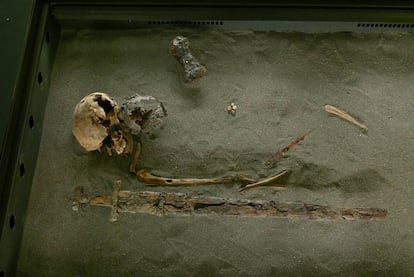
Stefánsson ruminates on his thoughts about death. One of his company’s most recent advancements is a method to predict a person’s death in five years. The researchers followed 23,000 Icelanders for 14 years, measuring the blood levels of thousands of proteins. The new tool was able to classify people in their sixties and seventies according to their proximity to death. In the group classified as high-risk, 88% of participants died. In the low-risk group, only 1% passed away. Stefánsson recognizes that this ability to predict someone’s death is “chilling.”
The doctor receives EL PAÍS after a visit to his facilities organized and paid by Amgen, the American pharmaceutical company that bought deCODE for €320 million in 2012. The Icelandic company couldn’t figure out how to convert its scientific discoveries into capital. In 2009, when the entire Nordic country sank in an economic crisis that ended up with dozens of corrupt financiers in prison, the company fell into bankruptcy. Stefánsson is a peculiar and controversial entrepreneur: he speaks more about poetry than business. He argues that a good scientist should read at least 50 novels every year. “The equipment you think with is your language. And to be able to think anything new you have to be good at using language. You have to be an acrobat of language,” he says.
Stefánsson says that he is sad and depressed. Six months ago, his wife of 53 years died. He is still “learning to live without her.” The doctor, who usually spends his vacations in Spain and adores poets like Antonio Machado and Octavio Paz, writes poetry to move through his pain. He asks himself a question out loud: “What is life?” He responds without lyricism: “Life are all self-assembling systems that contain DNA, allow DNA to replicate and on the basis of the replicated DNA form other self-assembly system of the same kind.”

To Stefansson, that is all. DNA, the molecule with the instructions to form a human being from a fertilized egg, just wants to multiply itself. It is a recipe, written in carbon, hydrogen, oxygen, nitrogen and phosphorus, that commands every human cell. “It is clear that DNA does not exist to serve the life forms. The life forms exist to serve DNA. They exist to allow DNA to persist on Earth. Preservation of DNA is the purpose of life,” he explains with a bitter smile. “That’s not very romantic, but there is no God. Which is unfortunate, because it would be really convenient to have one,” he adds ironically.
Stefansson remembers a poem he wrote one day in 1996, when the birth of Dolly the sheep, the first mammal cloned from another animal’s adult cell, led him to reframe the meaning of life. “Where do I find, lost in the brightness of a sunlit day, the happiness of an unhappy man, fortunate only to be just one copy of himself. Everything else stinks,” he recites, gesticulating.
Stefansson’s scientific production is unmatched. He has authored 5% of the studies published in the journal Nature Genetics in the last decade. But humanity is more complex than he had imagined when he founded deCODE. In 2003, Stefansson proclaimed that he hoped to develop “at least 10″ pharmaceuticals through his discoveries of genetic variants associated with illnesses. They still don’t exist. “There are things in development now who I hope will make it to the market sooner or later,” the doctor says.

The challenge is massive. The scientific community has known since 1980 that certain DNA mutations in a gene called KRAS, cause cancer in millions of people. But the first KRAS inhibitor medication reached hospitals only last year. Sotorasib, developed by Amgen, inhibits a specific mutation, called KRAS G12C, that is involved in 13% of non-small-cell lung cancer cases, the most common lung tumor. Biochemist Ray Deshaies, scientific vice-president of Amgen, explained at a Reykjavik press conference that “[the delay of over three decades] wasn’t because we didn’t know what we wanted to do, which was inhibit the mutation in KRAS, it’s just that we had no idea how to do it.”
Stefansson stretches his arms over the table. -”It’s easier to get a man to the Moon than to make a really good drug. But nevertheless, the industry does it,” he says. The doctor recalls the case of AIDS, caused by a virus detected in 1983, which has killed over 36 million people but now can be controlled with a single daily pill. “Which is beautiful. You have to admit that. So even though the pharmaceutical industry is a little bit annoying, it at least stands out,” he observes.
Amgen is one of the 15 largest pharmaceutical companies in the world, with earnings of €7 billion last year. Its price policy has become controversial in recent years: the drug blinatumomab, which fights an aggressive form of leukemia, appeared on the US market in 2014 for €145,000 per patient, becoming one of the most expensive cancer medications in the world.
Biologist Robert Bradway, Amgen’s executive director, affirmed in a Reyjavik press conference that not even one out of every 10 experimental drugs, which seem promising in animals, work in human trials. “Mice are wonderful. The problem with mice is that they are mice. They always have been and always will be mice. And mice are not terribly good at predicting what will happen in humans, so what might work as a cure for obesity in mice may not work as a cure for obesity in humans,” Bradway lamented. The majority of genetic variants discovered by deCODE only barely increase the risk of suffering from an illness: there are 3,000 associated with obesity, for example. But some of those mutations can reveal the mechanisms behind a pathology. That’s why Amgen decided to buy the Icelandic company in 2012.
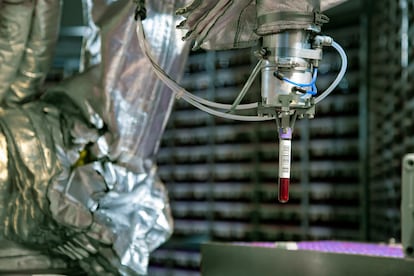
Bradway repeats a statistic common in the pharmaceutical industry: developing a drug takes 15 years and €2.3 billion. Those data points are debated by some organizations, such as the Swiss Drugs for Neglected Diseases Initiative, which has invested only €55 million to develop an effective drug against sleeping sickness. In 2021, Amgen’s executive director earned over €20 million, 166 times as much as the company’s average employee, according to public data from the organization.
Kari Stefansson admits the industry has its shadows. “There is certainly a certain conflict between the private or the for-profit companies that are making drugs and the public interest. I can, however, tell you that there’s much more of common interest than you may think,” he says. The doctor remembers that, weeks before Covid-19 forced humanity to shelter in their homes, he called the directors of Amgen to ask them for permission to research the novel coronavirus. “For heaven’s sake, do it,” they answered. His data demonstrated early on that half of the people infected were asymptomatic and that children rarely got sick. Iceland resisted the terrifying first wave of Covid much better than other countries.
The Icelandic doctor does, however, have enemies in high places. Bioethics expert Henry Greely, director of Stanford University’s Center for Law and Biosciences, has publicly spoken against Stefansson’s “notably abrasive” personality, accusing him of taking advantage of Icelanders without sharing the earnings. On the other hand, Icelandic economist Svala Gudmundsdottir has praised the deCODE founder’s “well-known generosity” after he donated expensive medical equipment to Rekjavik’s university hospital and for carrying out massive Covid tests free of charge.
The Icelandic company has the DNA of entire families on the island. The data analysis has revealed surprising keys to human personality. Stefansson speaks of “genetic nurture”: a parent’s genes, including those that their children do not inherit, mark a person’s destiny. The genes that you don’t have affect your grades in school, the age when you have your first child, your cholesterol levels and the number of cigarettes you smoke. “I think that our free will is extraordinarily limited. You’re genetically programmed to want certain things and you’re genetically programmed not to want other things,” Stefansson claims. “So I think free will is an illusion.”
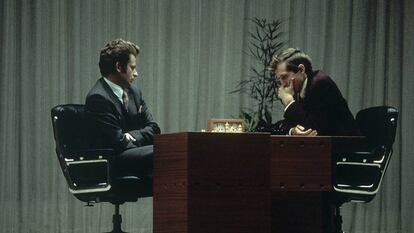
One of the best chess players in history, the American Bobby Fischer, moved to Iceland in 2005, fleeing from his country’s authorities, who sought to punish him for violating sanctions against Yugoslavia after participating in a friendly tournament in 1992. His escape to the Nordic island wasn’t a coincidence. Fischer had been an idol there since 1972, when he defeated the Soviet Boris Spassky in the midst of the Cold War. The encounter was a nuclear battle over a chess board. When he returned to Iceland over three decades later, sick and close to death, Bobby Fischer became friends with Kari Stefansson.
The 62-year-old master had lost his mind, victim of “a sort of paranoid psychosis,” as the Icelander recalls, obsessed with Jews, black people and women. Despite it all, the two new friends spent time together in Reykjavik, occasionally having “marvelous” conversations. The Icelandic documentary Me and Bobby Fischer (Fridrik Gudmundsson, 2010) shows some of those memorable talks. In one of them, from a moving car, the chess player rants about genetic research and compares it to the work of physicists who brought about the atomic bomb. The discussion, a veritable philosophy class, ends in shouts, even though Stefansson began trying to make amends.
—What we are doing in my company is simply trying to discover what life is about, we are not manipulating it in any way.
—Just like the scientists were trying to discover what the atom is all about and look where it has led.
—That has led to deeper understanding…
—It has led to stockpiling hydrogen bombs!
—That’s not the consequence of that.
—Yeeeeeeees.
—That is the consequence of evil exploitation of stupid people.
—The…
—Listen to me! If you are gonna try to put a ban on the discovery of new knowledge, you are beginning to control the world in an unpredictable manner, because you don’t know what the knowledge is until it has been discovered! So how are you going to control what we can discover?
Stefánsson remembers those discussions now. Since Bobby Fischer’s death in 2008, deCODE has continued to illuminate human beings’ genetic secrets, thanks to the 180,000 Icelandic volunteers and two million other people from around the world who have participated. Other countries, including the United Kingdom, have also begun large-scale attempts to read their citizens’ DNA. “Knowledge in and of itself is never an evil,” Stefansson insists. After a quarter-century discovering genetic differences among human beings, the Icelandic doctor is left with a lesson from his remote volcanic island: “We should have to remember that we are one species, we are one kind. And what separates us is so much less than what joins us. We should not use human diversity to discriminate against each other. We should celebrate human diversity.”
Tu suscripción se está usando en otro dispositivo
¿Quieres añadir otro usuario a tu suscripción?
Si continúas leyendo en este dispositivo, no se podrá leer en el otro.
FlechaTu suscripción se está usando en otro dispositivo y solo puedes acceder a EL PAÍS desde un dispositivo a la vez.
Si quieres compartir tu cuenta, cambia tu suscripción a la modalidad Premium, así podrás añadir otro usuario. Cada uno accederá con su propia cuenta de email, lo que os permitirá personalizar vuestra experiencia en EL PAÍS.
¿Tienes una suscripción de empresa? Accede aquí para contratar más cuentas.
En el caso de no saber quién está usando tu cuenta, te recomendamos cambiar tu contraseña aquí.
Si decides continuar compartiendo tu cuenta, este mensaje se mostrará en tu dispositivo y en el de la otra persona que está usando tu cuenta de forma indefinida, afectando a tu experiencia de lectura. Puedes consultar aquí los términos y condiciones de la suscripción digital.
More information
Últimas noticias
Pinochet’s victims grapple with José Antonio Kast’s rise in Chile
Reinhard Genzel, Nobel laureate in physics: ‘One-minute videos will never give you the truth’
Half of Scotland is in the hands of 420 property owners
From digital curfews to blocking apps: How technology experts protect their children online
Most viewed
- Pablo Escobar’s hippos: A serious environmental problem, 40 years on
- Reinhard Genzel, Nobel laureate in physics: ‘One-minute videos will never give you the truth’
- Why we lost the habit of sleeping in two segments and how that changed our sense of time
- Charles Dubouloz, mountaineering star, retires at 36 with a farewell tour inspired by Walter Bonatti
- The Florida Keys tourist paradise is besieged by immigration agents: ‘We’ve never seen anything like this’
